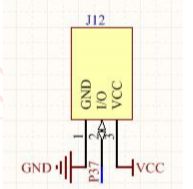- 基于STM32与Qt的自动平衡机器人:从控制到人机交互的的详细设计流程
极客小张
stm32qt机器人物联网人机交互毕业设计c语言
一、项目概述目标和用途本项目旨在开发一款基于STM32控制的自动平衡机器人,结合步进电机和陀螺仪传感器,实现对平衡机器人的精确控制。该机器人可以用于教育、科研、娱乐等多个领域,帮助用户了解自动控制、机器人运动学等相关知识。技术栈关键词STM32单片机步进电机陀螺仪传感器AD采集电路Qt人机界面实时数据监控二、系统架构系统架构设计本项目的系统架构设计包括以下主要组件:控制单元:STM32单片机传感器
- 51单片机——I2C总线存储器24C02的应用
老侯(Old monkey)
51单片机嵌入式硬件单片机
目标实现功能单片机先向24C02写入256个字节的数据,再从24C02中一次读取2个字节的数据、并在数码管上动态显示,直至读完24C02中256个字节的数据。1.I2C总线简介I2C总线有两根双向的信号线,一根是数据线SDA,另一根是时钟线SCL。I2C总线通过上拉电阻接正电源,因此,当总线空闲时为高电平。2.I2C通信协议起始信号、停止信号由主机发出。在数据传送时,当时钟线为高电平时,数据线上的
- 嵌入式单片机中数码管基本实现方法
嵌入式开发星球
单片机项目实战操作之优秀单片机
1.点亮数码管本节课利用已经学习的LED知识去控制一个8位数码管。本节的原理比较简单。不需要多少时间讲。更多时间是跟大家一起编码调试,从中学习一些编码思路和学习方法。1.1.什么是数码管数码管是什么?下图就是一个数码管从硬件上个看,其实就是8个LED组合在一起。8个LED应该有16个引脚,但是数码管上只有10个引脚。为什么呢?请看下图:1个LED有两个引脚,要控制LED,1个引脚接控制信号,另外一
- 4×4矩阵键盘详解(STM32)
辰哥单片机设计
STM32传感器教学矩阵计算机外设stm32嵌入式硬件单片机传感器
目录一、介绍二、传感器原理1.原理图2.工作原理介绍三、程序设计main.c文件button4_4.h文件button4_4.c文件四、实验效果五、资料获取项目分享一、介绍矩阵键盘,又称为行列式键盘,是用4条I/O线作为行线,4条I/O线作为列线组成的键盘。在行线和列线的每一个交叉点上设置一个按键,因此键盘中按键的个数是4×4个。这种行列式键盘结构能够有效地提高单片机系统中I/O口的利用率,节约单
- 学单片机怎么在3-5个月内找到工作?
无际单片机编程
单片机嵌入式开发物联网stm32c语言
每个初学者,都如履薄冰,10几年前,我自学单片机时,也一样。想通过学习,找一份体面点的工作,又害怕辛辛苦苦学出来,找不到工作。好在,当初执行力,还算可以,自学java没成功,后面自学单片机,成功入行了。转眼间,毕业到现在有13年了,马上也到了奔4的年纪。这13年一直在跟单片机打交道,打过工,创过业,对行业,对企业,都有一定的认知,坚持看完这篇内容,相信能帮你少走几个月弯路。有些老铁,加了我很久,时
- 51单片机:P3.3口输入/P 1口输出实验
li星野
单片机
51单片机:P3.3口输入/P1口输出实验一、实验内容1P3.3口做输入口,外接一脉冲,每输入一个脉冲,P1口按十六进制除2(乘2)。2.P1口做输出口,P1口接的8个发光二极管L1—L8按十六进制除2(乘2)方式点亮。二、仿真图三、代码实现C语言实现:#include#includesbitKEY=P3^3;voiddelay10ms(void);voidmain(){charnum=0xfe;
- 2020-11-12 写单片机内存的脚本 nc openocd 事务自动测试
linuxScripter
这是写单片机内存的脚本:z@z-ThinkPad-T400:~/zworkT400/EDA_heiche/zREPOgit/simple-gcc-stm32-project$catz.wholeRun.oneCase.cmdcattmp6.toWrite|awk'{system("echomwb"$1""$2"|nclocalhost4444");}'catUSER/DEBUG/debug.h|g
- 单片机中断
woainizhongguo.
STM32单片机原理解析篇单片机嵌入式硬件
**在51单片机中,中断向量表的地址是如何被设置的?**在51单片机中,中断向量表的设置是中断系统的核心部分,它定义了中断服务程序的入口地址。以下是中断向量表的设置方法:中断向量表的位置:51单片机的中断向量表通常位于程序存储器的起始位置,即地址0x0000到0x000F(对于双字节的中断向量,实际占用0x0000到0x001F)。这些地址是固定的,由单片机的硬件设计决定。中断向量的分配:每个中断
- 基于STC12C5A60S2单片机的LED汉字显示系统的设计
lantiandianzi
单片机嵌入式硬件
本设计基于单片机的LED汉字显示装置,该设计以STC12C5A60S2单片机为核心,利用最小系统和多个模块完成设计,包括点阵驱动模块、时钟模块、串口通信模块、红外线接收模块以及LED点阵屏。其中,点阵驱动模块采用74HC245芯片设计完成,结合DS1302时钟芯片完成LED点阵显示屏的汉字与时间显示,使用按键、串口、红外线遥控可以完成时间的实时更新、自定义汉字显示、改变汉字显示颜色、改变汉字滚动方
- 51单片机-AT24C02-实验2-秒表实验(可参考上一节)
Whappy001
51单片机嵌入式硬件单片机
利用定时器去对按键和数码管进行扫描(Whappy)main.c#include#include"LCD1602.h"#include"AT24C02.h"#include"Delay.h"#include"Timer0.h"#include"Nixie.h"#include"Key.h"unsignedcharKeyNum;unsignedcharMin,Sec,MiniSec;unsignedc
- 单片机在医疗设备中的应用实例教程
kkchenjj
单片机单片机嵌入式硬件
单片机在医疗设备中的应用实例教程单片机基础单片机概述单片机,全称为单片微型计算机(Single-ChipMicrocomputer),是一种将中央处理器(CPU)、存储器、输入输出接口等主要计算机部件集成在一块芯片上的微型计算机系统。它具有体积小、功耗低、成本低廉、控制功能强大等特点,广泛应用于工业控制、家用电器、汽车电子、医疗设备等多个领域。特点集成度高:单片机将计算机的主要部件集成在一块芯片上
- 单片机与传感器接口技术应用实例教程
kkchenjj
单片机单片机nosql嵌入式硬件
单片机与传感器接口技术应用实例教程单片机基础单片机概述单片机,全称为单片微型计算机(Single-ChipMicrocomputer),是一种将中央处理器(CPU)、存储器、输入输出接口等主要计算机部件集成在一块芯片上的微型计算机系统。它具有体积小、功耗低、成本低廉、控制功能强大等特点,广泛应用于工业控制、家用电器、汽车电子、通信设备、医疗器械等领域。特点集成度高:单片机将计算机的主要部件集成在一
- 掌握单片机,其实并不难
培林将军
单片机嵌入式硬件
Fearwillbeyourenemy恐惧将会是你的敌人单片机的学习绝不仅仅是对一项知识的掌握。想要学好单片机,需要从硬件结构、内部资源、外设应用等几个方面多方位入手。而要想成为一名嵌入式工程师,就要对单片机的基础非常熟悉,并且掌握C语言当中各个功能的初始化、启动、停止各类函数的编写调试。那么想要掌握单片机需要从哪几个方面入手呢?数字I/O的应用在大多数的单片机实验中,跑马灯实验正是数字I/O的典
- 无人机动力系统设计之电调芯片参数选型
lida2003
Physics无人机动力系统ESC
无人机动力系统设计之电调芯片参数选型1.源由2.关键因素2.1电压范围2.2电流处理能力2.3控制方式2.4PWM输出与分辨率2.5通讯接口2.6保护功能2.7支持霍尔传感器与无传感器模式2.8集成度与外围器件2.9效率与散热2.10市场供应与成本3.因素阐述3.1PWM工作频率3.1.1电机控制芯片3.1.2单片机算法定时器(Timers)电机控制部分3.2单片机工作频率Step1定时器频率St
- 实现单片机简单的时间片轮询调度
盘大海
单片机stm3251单片机mcu
时间片轮询调度1.创建一个结构体链表typedefstructtaskMember{pfuntiontaskName;volatileuint32_ttick;uint32_ttaskID;uint32_ttaskStatus;structtaskMember*listNext;}task_t;2.声明一个链表头。statictask_ttaskListHead;task_t*currentTas
- 单片机程序架构-时间片轮询架构
Jerry---
嵌入式单片机
1定时器复用说明(1)首先定义任务数、任务定时初值(任务轮询时间=定时初值*定时器中断时间)、任务定时计数器;(2)在定时器中断服务函数中添加【复用函数】。#defineTASK_NUM3//这里定义的任务数为3,表示有三个任务会使用此定时器定时。uint16_tTaskCount[TASK_NUM];//这里为三个任务定义三个变量来存放定时值uint8_tTaskMark[TASK_NUM];/
- 在单片机中,处于高阻态是什么状态
m0_69078052
单片机嵌入式硬件
在单片机(微控制器)中,高阻态(High-Z,HighImpedanceState)是指引脚的电气特性类似于没有连接状态,即该引脚的电流非常小,几乎不对电路产生影响。具体来说,高阻态具有以下几个特点:高阻态的特点输入状态:引脚不驱动任何电平(高电平或低电平),相当于引脚在电路中没有连接。此时,电路中的电流几乎为零。无干扰:高阻态的引脚不会对其他电路产生电气干扰或影响。它在逻辑上“断开”了与电路的连
- stm32单片机毕业设计方向推荐
Mdc_stdio
单片机
文章目录1前言2如何选题2.1不要给自己挖坑2.2难度把控2.3如何命名题目3单片机嵌入式选题大全3.1嵌入式方向3.2算法方向3.3移动通信方向3.4学长作品展示4最后1前言近期不少学弟学妹询问学长关于单片机和嵌入式相关的毕设选题,学长特意写下这篇文章以作回应!以下是学长亲手整理的物联网相关的毕业设计选题,都是经过学长精心审核的题目,适合作为毕设,难度不高,工作量达标,对毕设有任何疑问都可以问学
- 通信工程单片机毕设项目选题分享
cnhush
单片机stm32毕业设计
文章目录1前言2如何选题2.1不要给自己挖坑2.2难度把控2.3如何命名题目3单片机嵌入式选题大全3.1嵌入式方向3.2算法方向3.3移动通信方向3.4学长作品展示4最后1前言近期不少学弟学妹询问学长关于单片机和嵌入式相关的毕设选题,学长特意写下这篇文章以作回应!以下是学长亲手整理的物联网相关的毕业设计选题,都是经过学长精心审核的题目,适合作为毕设,难度不高,工作量达标,对毕设有任何疑问都可以问学
- STM32学习笔记(二、初识stm32单片机)
藏,捉
单片机stm32学习
一、stm32的含义是什么?首先stm32是意法半导体公司(ST)使用ARM公司的Cortex-M为核心生产的32位的单片机。其中,ST---意法半导体公司,即SOC厂商。M---为Microelectronics的缩写,即微型处理器。32---表示控制器为32位的。103---表示F系列的子系列。二、stm32的分类CPU位数内核系列描述32Cortex--M0STM32F0入门级STM32L0
- 单片机在汽车电子中的应用实例教程
kkchenjj
单片机单片机汽车mongodb
单片机在汽车电子中的应用实例教程单片机基础介绍单片机的定义与结构单片机,全称为单片微型计算机(Single-ChipMicrocomputer),是一种将中央处理器(CPU)、存储器(RAM和ROM)、输入/输出接口(I/O)、定时器、计数器等主要计算机功能部件集成在一块芯片上的微型计算机系统。它具有体积小、功耗低、成本低廉、控制功能强大等特点,广泛应用于各种控制领域,如工业控制、家用电器、汽车电
- 用五一最简单的板做一个智能循迹小车
21电信1刘天明
知识分享单片机嵌入式硬件
五一最简单板也就是单片机最小系统,或者称为最小应用系统,是指用最少的元件组成的单片机可以工作的系统.。这个系统适合初学者使用,并且制作智能小车,可以考验青少年的机械组装,器件链接,电子焊接,现场调试能力等。有一定挑战性,又十分有趣,深受青少年这个年龄段的喜爱,参加这样活动既能充分培养学生动手操作手脑协调能力,又有较高的思维训练价值,十分适合中小学生发展。做一个智能小车,首先你要学会一个编程语言并且
- GD32F103单片机-GPIO
侥幸哥f
GD32单片机GD32GPIO
GD32F103单片机-GPIO一、GPIO介绍二、GD32F103库函数介绍三、GPIO输入输出3.1GPIO输出-LED闪烁3.2GPIO输入-独立按键STM32GPIO部分见STM32F1单片机-GPIO一、GPIO介绍GD32的GPIO同STM32一样,GPIO可以配置成8种输入输出模式,由软件配置成推挽输出、开漏输出、复用推挽输出、复用开漏输出、上拉输入、下拉输入、浮空输入、模拟输入(A
- 单片机之从C语言基础到专家编程 - 4 C语言基础 - 4.14指针
fancyang
单片机之从C语言基础到专家编程单片机c语言嵌入式硬件
单片机之从C语言基础到专家编程-4C语言基础-4.14指针文章目录单片机之从C语言基础到专家编程-4C语言基础-4.14指针4.14指针1指针的概念2指针的声明与初始化3指针的算术运算4NULL指针1)定义和使用2)NULL指针的用途3)常见误区4)示例代码5)总结5字符串操作1)字符串的定义与初始化2)常用字符串操作函数3)字符串常量与指针6void*指针1)类型转换2)实现通用数据结构3)通用
- 单片机软件工程师确认硬件
蓝黑墨水
单片机嵌入式硬件
文章目录简介流程确认能连接usb和调试器确认芯片信息确认芯片存储是否正常确认屏幕是否能点亮确认其他硬件方式方法简介硬件工程师给出板子后,后面就是软件工程师的事儿了。通常来说并不会很顺利。流程确认能连接usb和调试器也是在“计算机管理”中或者在keil调试那里能发现你连的板子。确认芯片信息1,直接用眼看上面的封装信息2,使用相关命令确认一下确认芯片存储是否正常主要是确认芯片的存储是否正常。好几种情况
- 自适返回年的每月1号周几
智者知已应修善业
51单片机经验分享笔记算法
依据找到的年1月1日周一的规律自动推断参考年,配合年表可进一步减小计算出来的总天数在最小值,在单片机中用int类型变量就可以了,如此周而复始。void自适返回年的每月1号周几(int年){//依据找到的年1月1日周一的规律自动推断参考年,配合年表可进一步减小计算出来的总天数在最小值,在单片机中用int类型变量就可以了,如此周而复始。int年表[56]={6,11,6,5,6,11,6,5,6,11
- 使用PHP和MQTT构建高效的物联网数据转发服务器流程
极客小张
php物联网服务器单片机运维MQTT数据库
一、项目概述项目目标和用途本项目旨在搭建一个基于PHP的物联网服务器,能够接收来自各种传感器的数据,并通过MQTT协议将数据转发到其他设备或服务。该系统适用于智能家居、环境监测等场景,能够实现实时数据监控和远程控制。技术栈关键词PHPMQTTMySQLESP8266/ESP32(单片机)DHT11(温湿度传感器)Linux服务器Apache/Nginx二、系统架构系统架构设计本项目的系统架构主要由
- 【车载测试面试:各大车企面试题汇总】
@逝水流年轻染尘@
面试职场和发展
HIL(硬件在环)测试、UDS功能诊断、UDS自动化诊断、数据库制作、DTC故障制造、CANoe工具使用、ECU刷写、报文解析、导航测试、车控测试、OTA升级测试、TBOX测试等TBOX深圳涉及过T-BOX测试吗Ota升级涉及的台架环境是什么样的?上车实测之前有没有一个仿真环境台架环境都什么零部件T-BOX了解多少Linux和shell有接触吗单片机车机有没有热点啊WiFi这个功能有没有涉及一些法
- 单片机工程师:创新与挑战之路
嵌入式大圣
单片机嵌入式硬件
摘要:本文全面深入地探讨了单片机工程师这一职业角色。详细阐述了单片机工程师的职责范围、所需技能,包括硬件设计、软件编程、调试与测试等方面。分析了单片机在不同领域的应用,如工业控制、消费电子、智能家居等。同时,探讨了单片机工程师面临的挑战,如技术更新迅速、项目复杂性增加等,并提出了相应的应对策略。此外,还展望了单片机工程师的未来发展趋势,强调了持续学习和创新的重要性。目录一、引言二、单片机工程师的职
- 基于单片机多功能电子闹钟设计
创新电子设计
单片机单片机嵌入式硬件
**单片机设计介绍,基于单片机多功能电子闹钟设计文章目录一概要二、功能设计设计思路三、软件设计原理图五、程序六、文章目录一概要 基于单片机多功能电子闹钟设计是一个结合了单片机控制、时间显示、闹钟提醒以及其他附加功能的综合性项目。以下是该设计的概要:一、系统概述该设计以单片机为核心控制器,通过外围电路和模块实现时间的精确显示、闹钟提醒以及其他多种功能。整个系统注重易用性、精确性和稳定性,力求为用户
- 安装数据库首次应用
Array_06
javaoraclesql
可是为什么再一次失败之后就变成直接跳过那个要求
enter full pathname of java.exe的界面
这个java.exe是你的Oracle 11g安装目录中例如:【F:\app\chen\product\11.2.0\dbhome_1\jdk\jre\bin】下的java.exe 。不是你的电脑安装的java jdk下的java.exe!
注意第一次,使用SQL D
- Weblogic Server Console密码修改和遗忘解决方法
bijian1013
Welogic
在工作中一同事将Weblogic的console的密码忘记了,通过网上查询资料解决,实践整理了一下。
一.修改Console密码
打开weblogic控制台,安全领域 --> myrealm -->&n
- IllegalStateException: Cannot forward a response that is already committed
Cwind
javaServlets
对于初学者来说,一个常见的误解是:当调用 forward() 或者 sendRedirect() 时控制流将会自动跳出原函数。标题所示错误通常是基于此误解而引起的。 示例代码:
protected void doPost() {
if (someCondition) {
sendRedirect();
}
forward(); // Thi
- 基于流的装饰设计模式
木zi_鸣
设计模式
当想要对已有类的对象进行功能增强时,可以定义一个类,将已有对象传入,基于已有的功能,并提供加强功能。
自定义的类成为装饰类
模仿BufferedReader,对Reader进行包装,体现装饰设计模式
装饰类通常会通过构造方法接受被装饰的对象,并基于被装饰的对象功能,提供更强的功能。
装饰模式比继承灵活,避免继承臃肿,降低了类与类之间的关系
装饰类因为增强已有对象,具备的功能该
- Linux中的uniq命令
被触发
linux
Linux命令uniq的作用是过滤重复部分显示文件内容,这个命令读取输入文件,并比较相邻的行。在正常情 况下,第二个及以后更多个重复行将被删去,行比较是根据所用字符集的排序序列进行的。该命令加工后的结果写到输出文件中。输入文件和输出文件必须不同。如 果输入文件用“- ”表示,则从标准输入读取。
AD:
uniq [选项] 文件
说明:这个命令读取输入文件,并比较相邻的行。在正常情况下,第二个
- 正则表达式Pattern
肆无忌惮_
Pattern
正则表达式是符合一定规则的表达式,用来专门操作字符串,对字符创进行匹配,切割,替换,获取。
例如,我们需要对QQ号码格式进行检验
规则是长度6~12位 不能0开头 只能是数字,我们可以一位一位进行比较,利用parseLong进行判断,或者是用正则表达式来匹配[1-9][0-9]{4,14} 或者 [1-9]\d{4,14}
&nbs
- Oracle高级查询之OVER (PARTITION BY ..)
知了ing
oraclesql
一、rank()/dense_rank() over(partition by ...order by ...)
现在客户有这样一个需求,查询每个部门工资最高的雇员的信息,相信有一定oracle应用知识的同学都能写出下面的SQL语句:
select e.ename, e.job, e.sal, e.deptno
from scott.emp e,
(se
- Python调试
矮蛋蛋
pythonpdb
原文地址:
http://blog.csdn.net/xuyuefei1988/article/details/19399137
1、下面网上收罗的资料初学者应该够用了,但对比IBM的Python 代码调试技巧:
IBM:包括 pdb 模块、利用 PyDev 和 Eclipse 集成进行调试、PyCharm 以及 Debug 日志进行调试:
http://www.ibm.com/d
- webservice传递自定义对象时函数为空,以及boolean不对应的问题
alleni123
webservice
今天在客户端调用方法
NodeStatus status=iservice.getNodeStatus().
结果NodeStatus的属性都是null。
进行debug之后,发现服务器端返回的确实是有值的对象。
后来发现原来是因为在客户端,NodeStatus的setter全部被我删除了。
本来是因为逻辑上不需要在客户端使用setter, 结果改了之后竟然不能获取带属性值的
- java如何干掉指针,又如何巧妙的通过引用来操作指针————>说的就是java指针
百合不是茶
C语言的强大在于可以直接操作指针的地址,通过改变指针的地址指向来达到更改地址的目的,又是由于c语言的指针过于强大,初学者很难掌握, java的出现解决了c,c++中指针的问题 java将指针封装在底层,开发人员是不能够去操作指针的地址,但是可以通过引用来间接的操作:
定义一个指针p来指向a的地址(&是地址符号):
- Eclipse打不开,提示“An error has occurred.See the log file ***/.log”
bijian1013
eclipse
打开eclipse工作目录的\.metadata\.log文件,发现如下错误:
!ENTRY org.eclipse.osgi 4 0 2012-09-10 09:28:57.139
!MESSAGE Application error
!STACK 1
java.lang.NoClassDefFoundError: org/eclipse/core/resources/IContai
- spring aop实例annotation方法实现
bijian1013
javaspringAOPannotation
在spring aop实例中我们通过配置xml文件来实现AOP,这里学习使用annotation来实现,使用annotation其实就是指明具体的aspect,pointcut和advice。1.申明一个切面(用一个类来实现)在这个切面里,包括了advice和pointcut
AdviceMethods.jav
- [Velocity一]Velocity语法基础入门
bit1129
velocity
用户和开发人员参考文档
http://velocity.apache.org/engine/releases/velocity-1.7/developer-guide.html
注释
1.行级注释##
2.多行注释#* *#
变量定义
使用$开头的字符串是变量定义,例如$var1, $var2,
赋值
使用#set为变量赋值,例
- 【Kafka十一】关于Kafka的副本管理
bit1129
kafka
1. 关于request.required.acks
request.required.acks控制者Producer写请求的什么时候可以确认写成功,默认是0,
0表示即不进行确认即返回。
1表示Leader写成功即返回,此时还没有进行写数据同步到其它Follower Partition中
-1表示根据指定的最少Partition确认后才返回,这个在
Th
- lua统计nginx内部变量数据
ronin47
lua nginx 统计
server {
listen 80;
server_name photo.domain.com;
location /{set $str $uri;
content_by_lua '
local url = ngx.var.uri
local res = ngx.location.capture(
- java-11.二叉树中节点的最大距离
bylijinnan
java
import java.util.ArrayList;
import java.util.List;
public class MaxLenInBinTree {
/*
a. 1
/ \
2 3
/ \ / \
4 5 6 7
max=4 pass "root"
- Netty源码学习-ReadTimeoutHandler
bylijinnan
javanetty
ReadTimeoutHandler的实现思路:
开启一个定时任务,如果在指定时间内没有接收到消息,则抛出ReadTimeoutException
这个异常的捕获,在开发中,交给跟在ReadTimeoutHandler后面的ChannelHandler,例如
private final ChannelHandler timeoutHandler =
new ReadTim
- jquery验证上传文件样式及大小(好用)
cngolon
文件上传jquery验证
<!DOCTYPE html>
<html>
<head>
<meta http-equiv="Content-Type" content="text/html; charset=utf-8" />
<script src="jquery1.8/jquery-1.8.0.
- 浏览器兼容【转】
cuishikuan
css浏览器IE
浏览器兼容问题一:不同浏览器的标签默认的外补丁和内补丁不同
问题症状:随便写几个标签,不加样式控制的情况下,各自的margin 和padding差异较大。
碰到频率:100%
解决方案:CSS里 *{margin:0;padding:0;}
备注:这个是最常见的也是最易解决的一个浏览器兼容性问题,几乎所有的CSS文件开头都会用通配符*来设
- Shell特殊变量:Shell $0, $#, $*, $@, $?, $$和命令行参数
daizj
shell$#$?特殊变量
前面已经讲到,变量名只能包含数字、字母和下划线,因为某些包含其他字符的变量有特殊含义,这样的变量被称为特殊变量。例如,$ 表示当前Shell进程的ID,即pid,看下面的代码:
$echo $$
运行结果
29949
特殊变量列表 变量 含义 $0 当前脚本的文件名 $n 传递给脚本或函数的参数。n 是一个数字,表示第几个参数。例如,第一个
- 程序设计KISS 原则-------KEEP IT SIMPLE, STUPID!
dcj3sjt126com
unix
翻到一本书,讲到编程一般原则是kiss:Keep It Simple, Stupid.对这个原则深有体会,其实不仅编程如此,而且系统架构也是如此。
KEEP IT SIMPLE, STUPID! 编写只做一件事情,并且要做好的程序;编写可以在一起工作的程序,编写处理文本流的程序,因为这是通用的接口。这就是UNIX哲学.所有的哲学真 正的浓缩为一个铁一样的定律,高明的工程师的神圣的“KISS 原
- android Activity间List传值
dcj3sjt126com
Activity
第一个Activity:
import java.util.ArrayList;import java.util.HashMap;import java.util.List;import java.util.Map;import android.app.Activity;import android.content.Intent;import android.os.Bundle;import a
- tomcat 设置java虚拟机内存
eksliang
tomcat 内存设置
转载请出自出处:http://eksliang.iteye.com/blog/2117772
http://eksliang.iteye.com/
常见的内存溢出有以下两种:
java.lang.OutOfMemoryError: PermGen space
java.lang.OutOfMemoryError: Java heap space
------------
- Android 数据库事务处理
gqdy365
android
使用SQLiteDatabase的beginTransaction()方法可以开启一个事务,程序执行到endTransaction() 方法时会检查事务的标志是否为成功,如果程序执行到endTransaction()之前调用了setTransactionSuccessful() 方法设置事务的标志为成功则提交事务,如果没有调用setTransactionSuccessful() 方法则回滚事务。事
- Java 打开浏览器
hw1287789687
打开网址open浏览器open browser打开url打开浏览器
使用java 语言如何打开浏览器呢?
我们先研究下在cmd窗口中,如何打开网址
使用IE 打开
D:\software\bin>cmd /c start iexplore http://hw1287789687.iteye.com/blog/2153709
使用火狐打开
D:\software\bin>cmd /c start firefox http://hw1287789
- ReplaceGoogleCDN:将 Google CDN 替换为国内的 Chrome 插件
justjavac
chromeGooglegoogle apichrome插件
Chrome Web Store 安装地址: https://chrome.google.com/webstore/detail/replace-google-cdn/kpampjmfiopfpkkepbllemkibefkiice
由于众所周知的原因,只需替换一个域名就可以继续使用Google提供的前端公共库了。 同样,通过script标记引用这些资源,让网站访问速度瞬间提速吧
- 进程VS.线程
m635674608
线程
资料来源:
http://www.liaoxuefeng.com/wiki/001374738125095c955c1e6d8bb493182103fac9270762a000/001397567993007df355a3394da48f0bf14960f0c78753f000 1、Apache最早就是采用多进程模式 2、IIS服务器默认采用多线程模式 3、多进程优缺点 优点:
多进程模式最大
- Linux下安装MemCached
字符串
memcached
前提准备:1. MemCached目前最新版本为:1.4.22,可以从官网下载到。2. MemCached依赖libevent,因此在安装MemCached之前需要先安装libevent。2.1 运行下面命令,查看系统是否已安装libevent。[root@SecurityCheck ~]# rpm -qa|grep libevent libevent-headers-1.4.13-4.el6.n
- java设计模式之--jdk动态代理(实现aop编程)
Supanccy2013
javaDAO设计模式AOP
与静态代理类对照的是动态代理类,动态代理类的字节码在程序运行时由Java反射机制动态生成,无需程序员手工编写它的源代码。动态代理类不仅简化了编程工作,而且提高了软件系统的可扩展性,因为Java 反射机制可以生成任意类型的动态代理类。java.lang.reflect 包中的Proxy类和InvocationHandler 接口提供了生成动态代理类的能力。
&
- Spring 4.2新特性-对java8默认方法(default method)定义Bean的支持
wiselyman
spring 4
2.1 默认方法(default method)
java8引入了一个default medthod;
用来扩展已有的接口,在对已有接口的使用不产生任何影响的情况下,添加扩展
使用default关键字
Spring 4.2支持加载在默认方法里声明的bean
2.2
将要被声明成bean的类
public class DemoService {

